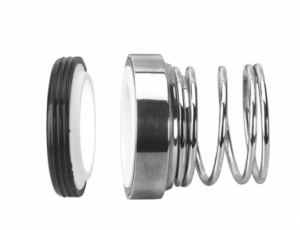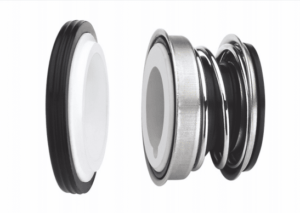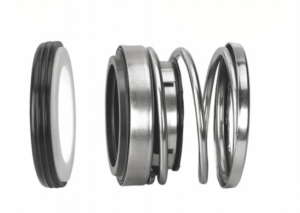Mechanical seal
Principle and Characteristic of Mechanical Seal
1.Sealing Principle
The key to the success of mechanical seal is to form and keep liquid film with a certain thickness, and reasonably pressure in the unit area between end faces has to be controlled to keep this layer of liquid film, thus it can acquire pretty higher mechanical seal technology , and effectively extend the usage life of the mechanical seal.
What is liquid film?
- A layer of very thin liquid film is kept between end faces to seal. This film is of liquid film dynamical pressure and stationary pressure, balancing pressure and lubricating end face.
- The thickness of liquid film on the mechanical seal end face represents the friction status of friction pair, directly affects the leak rate and the wear extend of the mechanical seal end face, and an important parameter to determine the thermal friction of the end face.
- When typical thickness of liquid film on the mechanical seal end face is 0.3~3μm, and the air film of dry air sealing end face is 3~5μm, this not only keeps better sealing and less leakage but also has longer working life and little friction.
What will happen if there is no liquid film?
- Dry contact of end faces, excessive wear, produce a great deal of friction heat , damage end face
2.Structure
(1)Constitution
(2)Fixation
Fastened screws of mechanical seal fix spring on the axle, and stationary ring is fixed with stationary seat with stop pin. While stationary seat is connected with equipment.
Mechanical seal mainly converts easily leaked axial sealing into difficult leaked end face sealing. As it is shown in the picture, when the axle rotates , it brings spring seat, spring pressure plate and rotating ring and other spare parts to rotate together, fixing rotating ring with stationary firmly due to the force of spring. When the axle rotates, rotating ring rotates with axle together, while stationary ring is fixed on the seat frame and keeps still, thus the annular sealing surface between rotating ring and stationary prevents the leakage of the medium.
Generally there are four sealing locations for mechanical seal:
- Sealing between rotating ring and stationary ring – rotating sealing.
- Sealing between rotating ring and axle or shaft sleeve- relative stationary sealing.
- Sealing between stationary ring and stationary seat- stationary sealing.
- Sealing between stationary seat(gland) and the equipment—stationary sealing.
3.Basic component
(1)Rotating ring and stationary ring
The require material of mechanical seal:
Better abrasive resistance, good thermal conductivity, and transfer friction heat out timely. Small porosity and tight structure , in case there is any seepage of medium under pressure.
Mechanical seal rotating ring and stationary is a set of friction pair, having different hardness. Generally the hardness of rotating ring is bigger than that of stationary ring.
The material of mechanical seal rotating ring can be cast iron, hard metal and high-alloy steel etc, and SS or the surface of SS can be used to weld hard metal and ceramics etc under corrosion environment; the material of stationary can be cast iron, phosphor bronze ,Babbitt metal etc, and also generally be impregnated graphite or Teflon.
The method of matching:
When the medium viscosity is small and the lubricity is poor , metal is matched with nonmetal( as the majority of nonmetal materials have the effect of self lubricating);when the medium viscosity is bigger, metal is matched with metal.
The requirement of processing precision:
As the end faces of the friction pair have the effect of sealing, and the friction rings are sliding friction mutually, thus the processing precision of the end faces affects sealing results and usage life.
(2)Spring loading device
Function:
Produce pressing force, keep tightly contact of ends between the rotating ring and stationary ring, and it is a buffer element, and is able to make up for unfitness of friction surfaces due to compensation shaft run-out and machining error.
(3)Auxiliary sealing element
O-shaped ring, V-shaped ring , straight-flanked ring etc.
4.The advantages and disadvantages of mechanical seal (compare with soft stuffing sealing)
Advantage of mechanical seal:
- Reliable sealing, no or little leakage in a longer usage period.
- Long usage life, mechanical seal with correct friction material can be used for 2-5 years, 9 years at longest.
- No maintenance under normal working conditions.
- Less friction power consumption.
- No wearing of shaft or shaft sleeve.
- Lack of sensitive to the deviation of the run-out of rotation axis and shaft-to- shell holes.
- Larger scope of application, mechanical seals are used for sealing of low temperature, high temperature, high vacuum, high pressure, all kinds of rotating speed and all kinds of corrosive, combustible, explosive, and poisonous mediums.
Disadvantages of mechanical seal:
- Rather complicate structure, and high requirement for machining process.
- It is required that workers have to be capable of certain installation technical level during installation and renewal.
Showing 1–12 of 717 results
Showing 1–12 of 717 results



